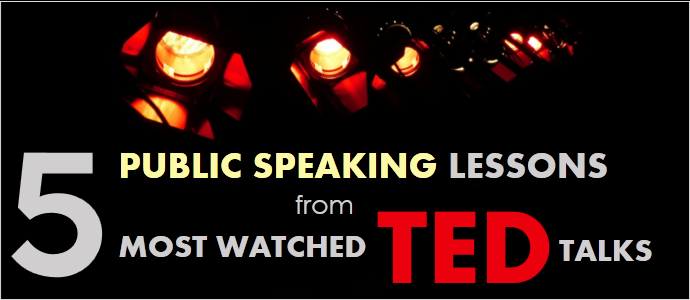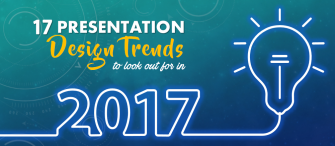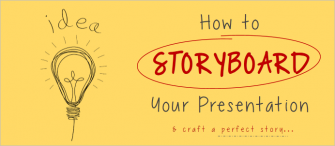Knowledge is power. And a very addictive type of power too. We are talking about TED talks, a revolution of “ideas worth spreading” and the zenith of public speaking.
If your brain chemicals are addicted to these profoundly inspiring and informative 18-minute TED talks, you are one lucky addict; don’t let go of this addiction. For whether we realize it or not, TED talks are a life-changing experience. Each talk inspires us to change ourselves for the better or look at everyday events with a different, richer and a wider perspective.
For presenters especially, TED talks have become a school of learning in themselves. Here’s why: The powerful oratory by TED speakers and their stage presence has been as important a factor, if not more, in the huge popularity of this event, as has been the powerful content and knowledge shared through this medium. Some talks, however, go a few steps further and become viral amongst the online viewers.
Here’s an honor to the 5 most watched TED talks of all time and the most powerful public speaking lessons that we can take away from their talks. After all, we all want our next presentation to be as powerful and appreciated by audiences as a TED talk (P.S. If you need to craft a TED-like impactful presentation, you can avail our Professional Presentation Design Services. The team has already crafted hundreds of winning keynote presentations for Fortune 500 companies and public speakers.)
1. Ken Robinson: Do Schools Kill Creativity
Sir Ken Robinson takes the top slot and when you listen to his talk you know why. The speaker strongly takes on the public education system for driving “creativity out of children” and does so very entertainingly. His frankness and a relaxed and conversational approach instantly endears him to the audience. Interspersing his contentions with personal stories, Ken Robinson makes witty comments about his wife, his son and his girlfriend, about university professors and himself leaving everyone in splits or generously amused. If you haven’t watched the number one TED talk, you have to do it now:
Public Speaking Lesson From This Talk
Inject Humor into Your Presentation: Don’t take yourself too seriously. Lighten up like Sir Ken Robinson did and you’ll surprise yourself with the difference in your talk and audience’s reactions. Notice how Sir Robinson blew away all the defenses the audience had with his candid opening:
Good morning. How are you? It's been great, hasn't it? I've been blown away by the whole thing. In fact, I'm leaving.
You do not have to crack jokes to be funny. Agreed that not all of us can be as witty as Sir Robinson but all of us have stories to share; light-hearted stories about the nature of our professions, our stupidities and common stereotypes. Like the speaker reinforced the “boring to death” image of university professors:
If you're at a dinner party, and you say you work in education -- Actually, you're not often at dinner parties, frankly...
If you work in education, you're not asked.
But if you are, and you say to somebody, you know, they say, "What do you do?" and you say you work in education, you can see the blood run from their face. They're like, "Oh my God," you know, "Why me?" "My one night out all week."
Self-deprecating humor is a great way to endear oneself to the audience. Taking jokes on yourself needs a lot of courage. Exaggeration is also a great technique to amuse the audience. Sir Ken Robinson remembers to use this to praise his wife’s multi-tasking abilities:
“...if she's cooking, she's dealing with people on the phone, she's talking to the kids, she's painting the ceiling, she's doing open-heart surgery over here. If I'm cooking, the door is shut, the kids are out, the phone's on the hook, if she comes in I get annoyed. I say, "Terry, please, I'm trying to fry an egg in here."
2. Amy Cuddy: Your body language shapes who you are
Social Psychologist Amy Cuddy makes a moving effort to inspire others to make tiny tweaks in their body language for big outcomes. Backed with lots of research, Amy Cuddy goes on to convince us that our non-verbals i.e. our body language not only influences what others think about us but also what we think and feel about ourselves. By trying “power posing” - hands on our hips, arms in a V- we can feel more powerful and give our best. She leaves the captivated audience with a mantra “Don't fake it till you make it. Fake it till you become it.”
Public Speaking Lesson From This Talk
Perfect Your Body Language: All of us spend too much time rehearsing our presentation content but hardly pay any attention to our body language. We should appear natural of course but if we are habitual to avoiding eye contact with audience or standing rigidly in one posture, we are sending all the wrong signals out there. Some presenters, on the other hand, may not have such brilliant content but they ooze confidence and charm with their non-verbal communication. Follow these tips agreed upon by all communication experts in perfecting your body language:
Avoid:
- Folding hands across your chest or keeping hands in the pocket. It shows you are not comfortable and makes the audience feel uncomfortable too.
- Hands on the hips. You do not have to try the ‘Wonder woman’ posture, as Amy Cuddy suggested in her talk, in front of the audience. Do it before and behind the stage to feel powerful.
- Playing, revolving or clicking the ballpoint pen in your hand. That’s quite irritating.
- Being stuck at one position on stage. It appears robotic.
Adopt:
- Hand gestures. Hubspot cited some public studies that found that the more presenters used hand gestures, the better they were rated by audiences. The most popular TED talks averaging 7,360,000 views had speakers who used an average of 465 hand gestures. When you use hands to reinforce your ideas, you appear more natural and authoritative.
- Walk calmly across the stage and face the audience towards each end. Most presenters focus on the audience in the center and ignore the ones on the side. When you move, you engage all sections of the audience.
- Eye contact with some audience members. Looking them in the eye shows your confidence and assertiveness. But this requires mastery over your content so that any weird expression on an audience member’s face doesn’t distract you.
- If you are following the first TED lesson i.e. humor, then this would be pretty easy to follow. Otherwise too, smiling occasionally during your talk shows your liveliness. If you have a beautiful smile, then this is a powerful weapon to captivate the audience!
3) Simon Sinek: How great leaders inspire action
We have all pondered over the question why some companies or personalities fail while others succeed? Leadership expert Simon Sinek gives a simple yet powerful reason for this difference using examples like Martin Luther King, Apple, and the Wright Brothers. The idea he shares is so simple it can be applied to any human effort to succeed and persuade others. This talk is a must for those who wish to be leaders as it reveals the secret behind what convinces people and drives them to action. Watch the video to know the golden circle of success:
Public Speaking Lesson From This Talk
You don’t need a PowerPoint or Keynote to captivate audience: If you know your content rocks, you don’t need any visual supplement at all. Simon Sinek knew he had found the answer to the most asked question “What makes a great leader” and he was going to drive it straight to the audience without any audio-visual support. Like a lecture, instead, Simon simply draws the golden circle on a board to explain the difference between leaders and followers. You can see he has not “memorized” his presentation. He just goes with the flow: introduces a problem, gives the solution, cites examples and guides the audience how to apply the new finding in their life. With this basic structure in hand, Simon hits all the right notes without worrying about what the next slide would be. So if you know your content very well and believe you can rely on your presentation skills alone, you can give PowerPoint or Keynote a break for a while.
4) Brene Brown: The power of vulnerability
Vulnerability researcher and author Brene Brown gives an insightful and touching talk on human connection and how embracing one’s vulnerability is crucial to self-worthiness and connection with others. Years of research and her own slug fest with vulnerability, the consequent defeat and victory and the experience of universal emotions of shame, longing, love and acceptance strikes a chord with the audience. No wonder then, it is one of the top 5 TED talks of all time.
Public Speaking Lesson From This Talk
Make the right use of Pause: Brene Brown appears to be in no hurry, even though she has only 18 minutes to present her years of research. She makes generous use of pauses- at the right moments. Not only does that give her a second or two to recollect her thoughts, it also adds drama and punch to her words. Like it does to the following words in the sentence below: joy, creativity, belonging and love.
And I know that vulnerability is the core of shame and fear and our struggle for worthiness, but it appears that it's also the birthplace of joy, [pause] of creativity, [pause] of belonging, [pause] of love.
She even runs at places and speaks in a single breath which lends variation to the tone:
[Fast pace] we all know that feeling: "I'm not blank enough. I'm not thin enough, rich enough, beautiful enough, smart enough, promoted enough."
She occasionally uses long pauses which raises curiosity and gives a dramatic effect to her statement.
I'm going in, I'm going to figure this stuff out, I'm going to spend a year, I'm going to totally deconstruct shame, I'm going to understand how vulnerability works, and I'm going to outsmart it. So I was ready, and I was really excited. [Long Pause] As you know, it's not going to turn out well.
The audience breaks into laughter for they didn’t expect that it would not turn out well for her. A long pause builds up curiosity and excitement. Pauses also show the presenter’s confidence and calmness having a ripple effect on the audience.
5) Jill Bolte Taylor: My stroke of insight
This is my favorite talk. Here’s why: This has one of the most beautiful stories I have ever heard. And also has on display one of the most powerful orations. Brain researcher Jill Bolte Taylor got a serendipitous opportunity to study her own brain when she suffered a brain stroke one morning. She could not walk, talk, read, write or recall any of her life. “I essentially became an infant in a woman's body,” she narrates. But in that moment, Jill experienced something which some would call a near-death experience, others spiritual enlightenment. As she lost her left brain (the rational brain) and the right brain (emotional brain) took over, she found herself drifting into a “la la land”- a land of bliss and energy. Listen to the complete story in her TED talk:
Public Speaking Lesson From This Talk
Nothing Beats the Power of the Story: The full power of story was at play there in Jill Bolte Taylor’s TED talk. We are ‘emotional beings first, rational beings later’ thought got more credibility as Taylor transported us to re-live her “tragic” experience- brain stroke. Taylor went into profound details to explain her experience of nirvana when the right brain took over the left brain. When you feel you are going to cry with her at the tragedy, she sends the audience into an emotional rollercoaster – a laughter ride all of a sudden. Like she did right in the middle of her fantastic story:
And in that moment, my right arm went totally paralyzed by my side. Then I realized, "Oh my gosh! I'm having a stroke!" And the next thing my brain says to me is, Wow! This is so cool!
This is so cool! How many brain scientists have the opportunity to study their own brain from the inside out?"
And then it crosses my mind, "But I'm a very busy woman!"
There is no single flat surface in the talk but a rise and fall like the waves, keeping us riveted to our seats and hanging tightly to our headphones. The fluctuations in her tone, abundant use of hand gestures and the emotional delivery style worked magic. It’s like the audience suffered a brain stroke along with her. We shared her pain and joy. That’s the power of the story- it overcomes all physical and mental barriers and unites the speaker and audience like nothing else.
Harry Potter, Lord of the Rings and many other great stories have imprinted themselves in our minds and hearts. According to Harvard Business Review 2013, “To involve people at the deepest level you need to tell stories.”
When talks have stories, it’s similar to reading stories; just that you are reading with your eyes and ears at the same time. So find your story- it doesn’t have to be a personal experience alone- it can be any story relevant to your topic and your target audience.
Quick Revision: 5 Top Tips from Top TED Talks
- Inject Humor into Your Presentation
- Perfect Your Body Language
- You don’t need a PowerPoint or Keynote to captivate audience
- Make the right use of Pause
- Nothing Beats the Power of the Story
With these in your presentation, you are ready to give competition to the best presenters in the world! Stay tuned for more TED inspirations on our blog.





 Customer Reviews
Customer Reviews

















